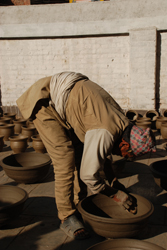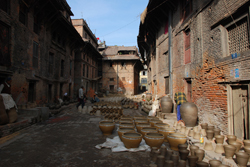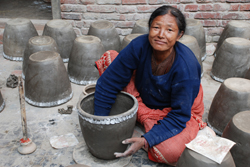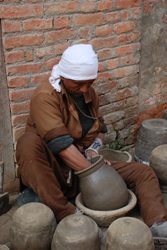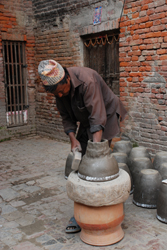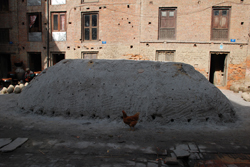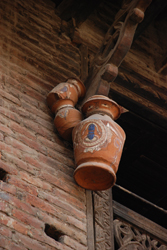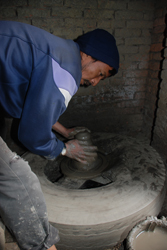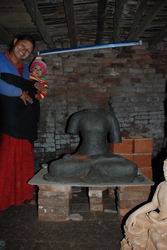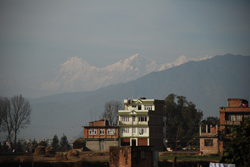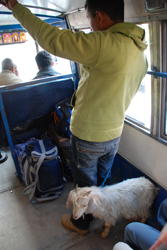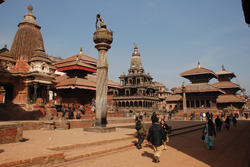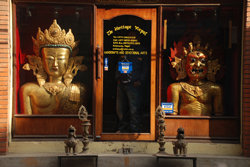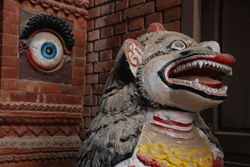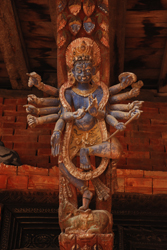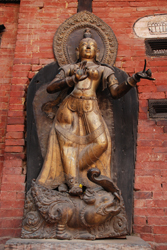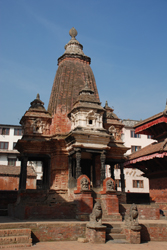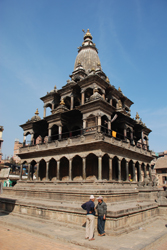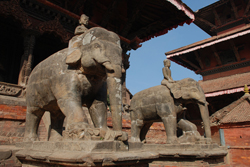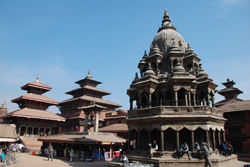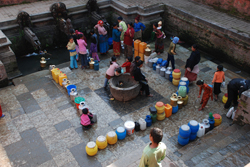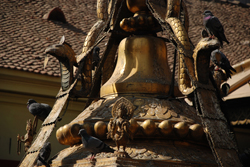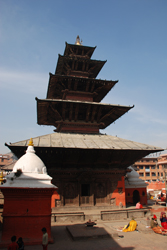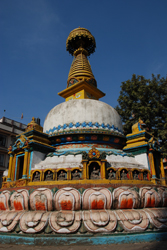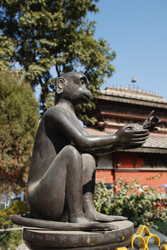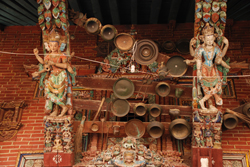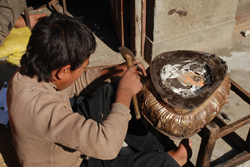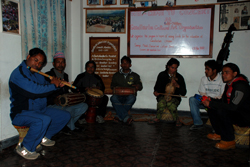Thimi: Town of Potters
19 January, 2009, 04:20 am in "Nepal"
Thimi is a quiet town which occupies an area between the old and new highways to Bhaktapur. It is known for its mask makers and potters.
We entered the town through the gate near the new highway and walked up a steep hill. Soon we began passing Newari buildings and temples. What was different were the rows of ceramic pieces set on the street to dry or sometimes in temple platforms. One shrine had piles of ceramics being stored inside.
We entered the town through the gate near the new highway and walked up a steep hill. Soon we began passing Newari buildings and temples. What was different were the rows of ceramic pieces set on the street to dry or sometimes in temple platforms. One shrine had piles of ceramics being stored inside.
On one back street we saw people making pieces as well as piles of clay and hay. The pieces are rough-- some made on the wheel but more made by pounding clay with large wooden mallets.
In another courtyard we found the kiln, a big pile of ashes and broken ceramics with air holes poked into it. Many buildings had clay pots hanging from the roof struts near the windows. Rowshan watched someone work at a wheel, then tried his hand at pounding a piece out. One woman beckoned us to come in and see the terracotta Buddha statues she worked on. They were from a mold then finished by
hand.
hand.
Since Rowshan had gotten his ceramics fix, we continued North to where we could see the mountains rising behind new brick houses, past rice paddies and fields. Our bus ride back had a goat passenger.
[ View 1 Comments
|
]
Patan: The Kingdom of Artisans
19 January, 2009, 03:20 am in "Nepal"
There are these weird photos of Durbar Square in Kathmandu with huge mountains rising behind it. We determined it was a Photoshop job because you don't see any mountains from Kathmandu. Well, surprise, surprise! Today we could see ranges of huge snow-capped peaks glittering through the haze. I still think the photos are faked-- the mountains were way too large. But you can see the Himalayas from Kathmandu.
Patan is a short bus ride from Kathmandu. It is a town that has been absorbed into Kathmandu though once it was its own kingdom.
We had to walk a little to get to Durbar Square, the historic center of Patan. We began to see the Newari carved windows and some temples. In Patan, you have to be on the lookout for some of the temples because they have a tendency to hide down alleys and side streets. They are easy to walk right by. We almost walked by one, I don't even know what it was called because I couldn't find it on the map. There were 2 painted lions outside an arch. We walked through and found a courtyard with some stupas and an ornate wall of statues, carvings and sculptures.
Patan is a short bus ride from Kathmandu. It is a town that has been absorbed into Kathmandu though once it was its own kingdom.
We had to walk a little to get to Durbar Square, the historic center of Patan. We began to see the Newari carved windows and some temples. In Patan, you have to be on the lookout for some of the temples because they have a tendency to hide down alleys and side streets. They are easy to walk right by. We almost walked by one, I don't even know what it was called because I couldn't find it on the map. There were 2 painted lions outside an arch. We walked through and found a courtyard with some stupas and an ornate wall of statues, carvings and sculptures.
Durbar square was an impressive space filled with red brick buildings with dark wood carved windows and eves. The structures were mainly built between the 14th-18th centuries.
We visited Mul Chowk (There are 3 chowks or courtyards) and noted it seemed to be decorated with dried intestines. Surrounding the courtyard were buildings with painted carved struts, each of a wooden god on his/her mount. At little scene was carved underneath.
We visited Mul Chowk (There are 3 chowks or courtyards) and noted it seemed to be decorated with dried intestines. Surrounding the courtyard were buildings with painted carved struts, each of a wooden god on his/her mount. At little scene was carved underneath.
There were 2 bronze statues of river goddesses in front of Talehu Bhawani temple-- one was on a turtle, the other on a creature which was supposed to be a “mythical crocodile” but had an elephant's trunk and wings.
We wandered around the square looking at the various temples including the Mughal influenced Krishna Mandir, the Vishwanath Temple (to Shiva) with elephant sculptures in front, an octagonal Krishna Temple, and the Jagannarayan Temple.
The Manga Hiti is a sunken area (once a pool), which had several lines of water containers (I presume the owners of them were waiting their turn elsewhere). It is quite sad that in the largest city in Nepal, people must go to the square to get water from public sources.
Next we walked out of Durbar Square and visited the Golden Temple which had impressive metal statues in the courtyard, monkey sculptures in the corners and an upstairs monastery with beautiful paintings.
Up the street was the Kumbeshwar Temple with 5 roofs. It is a tall structure. The area was full of kids playing, stray dogs wandering and some bedraggled sheep and a goat with a limp. At first I thought the animals were for sacrifice. Then I thought they were a bit too pathetic and bedraggled for sacrificial victims. Laundry (probably washed in the sunken water fountain) hung on the fence along one side of the temple.
South of Durbar we visited the Minnath Temple and the Swayambhu Stupa- an ornate but small stupa behind the temple. It also had 4 monkeys making offerings which I thought kind of interesting since they are more known for taking things.
From there we walked down a street full of craftsman's workshops. Patan, or Lalitpur as it was also known, is known for its craftsmen and artisans-- especially the metal workers. According to the tourist info brochure, Lalitpur has produced, “The highest number of talented artists and finest craftsmen ever recorded in Nepalese history. The most famous Newari artists and master craftsmen, like Arniko, Abbay Raj, and Siddhi Raj, were all born in Lalitpur. This was easy to believe as we walked down the street with the sound of hammers and blowtorches in the background as craftsmen worked on small metal sculptures using daylight as they sat in open walled shops.
The Gandharbas of Kathmandu
19 January, 2009, 02:57 am in "Nepal"
The Gandharba Culture and Arts Organization (GCAO) has a rather misleading sign that seems to point down the street when the office is actually in the alley under where the sign is placed. Fortunately, before we ended up on a fruitless search down the wrong street, a young man handed us a brochure advertising a free Nepali music concert. He led us through the alley up a dark stairway apologizing for the lack of electricity-- a fact of life in Nepal due to the “Load shedding” power cuts.
There was still a little light coming through the window into the small room where a group of young men sat with drums, sarangi (Nepali carved wooden violin) and flutes. As we walked in and sat down they leaped into action and began playing.
It was a casual setting and quite enjoyable. They sang as well. Sometimes one would get up and dance. Little by little, more musicians filtered in, many carrying sarangis. Eventually there were about 20 musicians in the small room as well as a couple more tourists who stopped by for a bit.
Many of the musicians we recognized as sarangi sellers who frequent the Thamel streets. This is part of a program of the GCAO to improve music instrument business for their members.
The music is bright and cheerful and reminiscent a little of bluegrass and Celtic music. The concert went on for about 1 hour (½ hour for each group of tourists).
The goal was to get support for their organization through CD purchases and donations as well as share their music. Their nightly concerts are a welcome escape from the western rock music blasting from Thamel clubs.
All the performers are from the Gandharba or gaine caste. They were considered an “untouchable” caste and were made up of musicians and performers. In addition to performing, the Gandharbas were the carriers of news and gossip through the distant villages. Although Nepal banned discrimination based on caste, the Gandharbas still suffer the effects from their forced low position in society, as well as from their livelihood being replaced by modern media.
The GCAO seeks to “keep the Gandharba traditions alive and improve their economic status”. They do this through improving education for the Gandharba people, increasing economic opportunities, motivating the Gandharba who are oppressed and destitute to live with self respect and dignity, and raising public awareness. They also work in support of the other “untouchable” (Dalit) castes.
If in Thamel, Kathmandu, stop by between 5PM and 7PM for the cultural program. If outside of Kathmandu, visit their website GCAO
There was still a little light coming through the window into the small room where a group of young men sat with drums, sarangi (Nepali carved wooden violin) and flutes. As we walked in and sat down they leaped into action and began playing.
It was a casual setting and quite enjoyable. They sang as well. Sometimes one would get up and dance. Little by little, more musicians filtered in, many carrying sarangis. Eventually there were about 20 musicians in the small room as well as a couple more tourists who stopped by for a bit.
Many of the musicians we recognized as sarangi sellers who frequent the Thamel streets. This is part of a program of the GCAO to improve music instrument business for their members.
The music is bright and cheerful and reminiscent a little of bluegrass and Celtic music. The concert went on for about 1 hour (½ hour for each group of tourists).
The goal was to get support for their organization through CD purchases and donations as well as share their music. Their nightly concerts are a welcome escape from the western rock music blasting from Thamel clubs.
All the performers are from the Gandharba or gaine caste. They were considered an “untouchable” caste and were made up of musicians and performers. In addition to performing, the Gandharbas were the carriers of news and gossip through the distant villages. Although Nepal banned discrimination based on caste, the Gandharbas still suffer the effects from their forced low position in society, as well as from their livelihood being replaced by modern media.
The GCAO seeks to “keep the Gandharba traditions alive and improve their economic status”. They do this through improving education for the Gandharba people, increasing economic opportunities, motivating the Gandharba who are oppressed and destitute to live with self respect and dignity, and raising public awareness. They also work in support of the other “untouchable” (Dalit) castes.
If in Thamel, Kathmandu, stop by between 5PM and 7PM for the cultural program. If outside of Kathmandu, visit their website GCAO
Powered by My Blog 1.69. Copyright 2003-2006 FuzzyMonkey.net.
Created by the scripting wizards at FuzzyMonkey.net..
(Code modified by Rowshan Dowlatabadi)
Created by the scripting wizards at FuzzyMonkey.net..
(Code modified by Rowshan Dowlatabadi)


